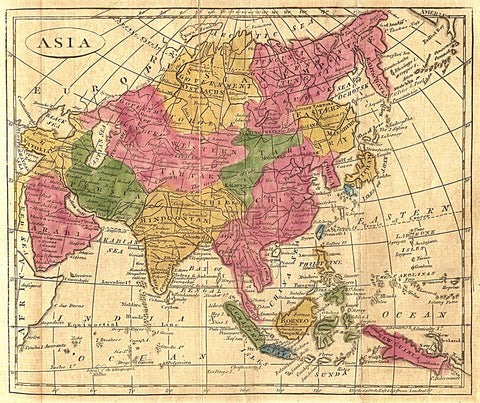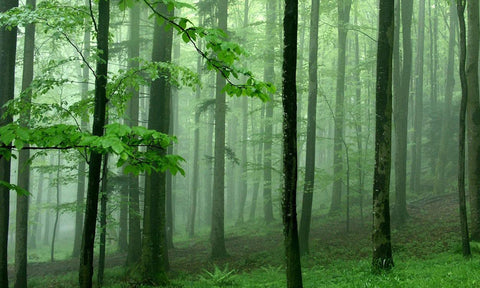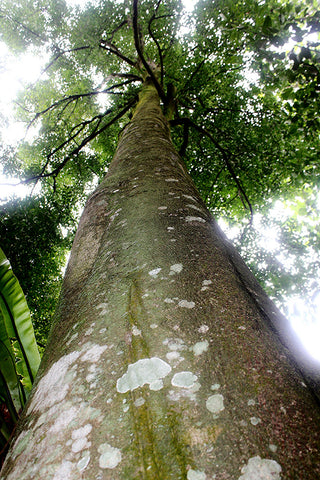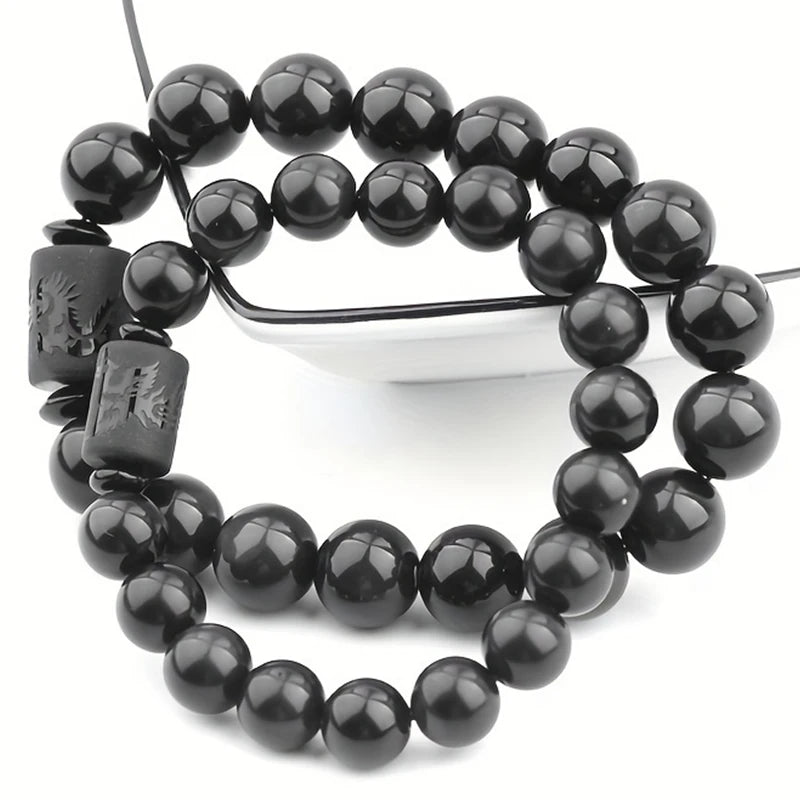Everything you need to know about Bois de Oud - One of the most precious woods in the world:
In short, what is oud wood?
It's a piece of wood loaded with a fragrant resin and dark color forming in the core of the trunks of certain types of trees most commonly found in the heart of forests in Southeast Asia.
This extremely rich and fragrant resin is formed as a result of physical or biological reactions on wood, usually as a result of attack by bacteria causing mold. Used in Asia for several centuries BC, it is mainly used for its medicinal properties as well as for its fragrance and noble appearance, but also in art in religion. Oud wood is marketed in 3 main forms: in its raw form, in powder and in oil. Its facultiesés and its rarityé make it one of the 10 most expensive woods in the world.
Variations in the name of agarwood:
- Cambodia : "Chann crassna"
- Chinese Cantonese (Hong Kong) : "Cham Heong"
- Chinese Mandarin : "Chénxiāng" (沉香), "chenshuixiang" and "shuichenxiang"
- India (Hindu) : "Agar" or "aguru", but also "agor" or "agoro" in Bengal
- Japan : commonly called "jinkō" or "jinkoh" (沈香). "Kyara" (伽羅) serving as the highest grade designer (best quality)
- Arab and Muslim countries : "Oud" or "oodh" (عود)
- Indonesia and Malaysia : "Gaharu"
- Anglo-Saxon and Western countries: "Eagle wood" or "Lignum aquila" (eagle wood), "agilawood" (akila wood), "aloeswood" or "lignum aloès" (aloe wood), "agar wood" (wood of akila) agar), "gaharu", "agila" (akila)
- Tibet : ཨ་ ག་ རུ་ (a-ga-ru). However, there are different varieties used in medicine: unique eagle antler: ཨར་ བ་ ཞིག་ (ar-ba-zhig); yellow eagle antler: ཨ་ ག་ རུ་ སེར་པོ་ (a-ga-ru ser-po), white eagle antler: ཨར་ སྐྱ་ (ar-skya), and finally eagle antler black: ཨར་ ནག་ (ar-nag)
- Thailand : Mai Ketsana (ໄມ້ ເກດ ສະ ໜາ)
- Vietnam : "Trầm hương" "

Trees producing oud wood:
To date, the existence of 4 families of trees that can produce calambac is known:
- Thymeleaceae (Thymelaeaceae in Latin) : this tree family is mainly found in Southeast Asia, and is mainly composed of trees of the aquilaria type
- Burseraceae (Burseraceae in Latin) : these trees are mainly found in South America
- Lauraceae (Lauraceae in Latin): also located in South America
- Euphorbiaceae (Euphorbiacaee in Latin) : mainly found in the tropics
However, trees of the genus aquilaria are the most widely used for agarwood production, as they are easier to grow, and the quality of its resin is one of the highest.

The formation of aloe wood and its resin:
There are 5 factors that can contribute to the formation of eagle antler which are as follows:
- Raw training : When branches crack or fracture as a result ofénatural events such as wind or thunderstorms, but also from animal scratches or from the cutting of branches by humans. Following these attacks, the trees will secrete resin to heal their wounds, which will produce calambac.
- Formation by ripening : Trees can wither and die from the continual production of resin which can block these veins and canals. Over a long period of time, the wood fibers mix with the resin and solidify, forming a premium, very dark, hard wood that will sink in water.
- Ablation training : Following infection, injured parts of the tree may fall off. These pieces are usually loaded with agarwood resin.
- Formation by insect attacks : Trees are sometimes attacked by parasitic insects, and form resin in order to protect and heal themselves from these external attacks.
- Fungal formation: The wood is attacked by fungi which produce moss on the outside of the tree. In order to protect himself from it, it secretes resin.
The resin formation of eagle wood takes place in the heart of the tree trunks for the purpose of self-defense. Unaffected wood is light in color, but the resin considerably increases the mass and density of the affected wood, changing its color from pale beige to dark brown or even black, which is why oud wood can sink in water.
In forests, only 7% of trees are naturally affected by fungi, however, various methods are now used to infect trees so that the resin develops there.
Oud oil can be distilled using an agarwood chip distillation process. 70 kg of oud wood are needed to create 20 ml of oil.

The different quality levels of calambac:
The quality level of agarwood is called "grade", and its classification varies depending on its origin. The formation of gaharu is attributed to various factors, such as the species of the tree, the climate, the quality of the soil, the various attacks suffered by the wood and their level, and the time during which the wood will secrete resin in order to to heal. Due to a lack of uniformity in international standards and regulations, assessing the quality of eagle wood remains extremely complex. Therefore, its assessment depends primarily on the experience and knowledge of members of the industry. For convenience, we have simplified its evaluation into several categories, while from a scientific point of view, there are different categories and sub-categories of quality, or even more… The grade levels of agarwood differ according to the countries of production. :
- Malaysia (6 grade levels - Superior atInferior): "Double super" and "Super", "A", "B", "C" and "D".
- Indonesia (4 grade levels - Superior atInferior) : "Super A", "Super B", "Super C" and "Sabak"
- India (7 grade levels - Superior atInferior) : "Triple Super", "Double Super" and "Super", "A", "B", "C" and "D".
- Vietnam (5 grade levels - Superior atInferior) : Grade 5, 4, 3, 2 and 1.

Agarwood in history:
Oud wood has at least 3000 years of history, and its use began in China, Japan, India and the Middle East. At that time, only kings, emperors and the rich could benefit from it and appreciate its virtues. Let's retrace chronologically the appearances of agarwood throughout history:
During the time of the pyramids and the pharaohs, the Egyptians used it in their ritual to embalm the bodies of privileged families.
Between 800 and 600 BC. J.-C., Gaharu is mentioned in Sushruta Samhita, which is a Sanskrit (ancient Hindu) text about medicine and surgery of the time. He is also mentioned in the biography of an emperor of North India (Harshacharita) in 700 BC. J.-C.
Also at the same time (600 BC), Xuanzang, a Buddhist monk from China, describes the use of aloe wood and its oil for writing sacred texts.
In 600 BC. J.-C., in Japan, the Chronicles of Japan written called "Nihon Shoki", which is the second oldest book on the classical history of Japan, mentions the existence of aloe wood, following the discovery of a piece of wood identified as being native to Pursat, Cambodia, due to its typical scent of aloe wood from that region. This piece of wood is still in existence today, and belongs to the National Museum of Nara. It is exhibited to the public less than 10 times a century, to prevent damage.
In 300 BC. J.-C., in Ancient China, the Chronicles of Nan Zhou Yi WU Zhi (Strange Things from the South) written by Wa Zhen of the Wu Dynasty, mentions aloewood (agarwood). It was later discovered that wealthy families in Ancient China used calambac to design the coffins of their deceased.
Buddhists used aloe wood for their mala (long bracelets or necklaces made of 108 wooden beads).
In the year 800, the use of oud wood for its medicinal properties is also mentioned in the Hadith Qudsi (Sacred Words) of Sahîh Muslim.
In France, King Louis XIV soaked his clothes in rose water, water that had been previously boiled with oud wood.

The uses of calambac:
Throughout history and in our present day, eagle antler has been used for medicinal, spiritual or religious purposes as well as artistic. Here are the most common uses:
- Religious : Agarwood is used in many religions and philosophies, during rites or sacred ceremonies (weddings, funerals, prayers, etc.). It is mainly used by Buddhists (Buddhism), Taoists (Taoism), Hindus (Hinduism), Muslims (Islam), Catholics (Catholicism) and Christians (Christianity).
- Medical : Gaharu has a recognized medicinal and therapeutic use, in particular through traditional medicines in China, Arab, Tibet, India and Southeast Asia.
- Artistic : Its pleasant aroma and its rarity make calambac a precious material for sculpture. Large, intact pieces of aloe wood for the purpose of carving are rare to find. Very few works of art made entirely of oud wood are found, and furniture entirely made of calambac is even rarer.
Note that nowadays, eagle wood is used more and more in the world of fashion and beauty, since it is used for the creation of perfumes, incense, but also jewelry.

The virtues of agarwood:
Oud wood is recognized for its multiple benefits on the body and has been used in traditional Chinese medicine for thousands of years. Rich in terpenoids (natural sedative and anxiolytic) as well as in polyphenols (natural antioxidant), it is used for religious, artistic and medical purposes for its ability to soothe the body and mind, but also as part of diets, detoxification and digestion cures. Oud wood is recognized as a precious ally for health, beauty and general well-being (energy balance), sleep disorders, cholesterol, and much more… Psychoactive, it acts positively on psychic functions and mental.
Calambac in the form of incense is more commonly used for relaxation, relaxation and meditation, while the infusion has wider and deeper effects and virtues on health.
Detailed summary of the virtues and benefits of eagle wood:
- Medical benefits :
- Recommended as a supplement for the treatment of serious illnesses and conditions such as diabetes, cholesterol, cancer, asthma, rheumatism
- Thanks to its balancing functions, eagle wood reduces blood pressure and acts positively on the respiratory and digestive system, particularly in the context of the following ailments and contexts: Diet and detoxification / Reduction of uric acid / Elimination of constipation / Treatment of upset stomach, colic, diarrhea, nausea, vomiting and liver pain (related to a liver attack or liver disease)
- Containing natural sedatives and anxiolytics, oud wood is used in the treatment of insomnia, and on disorders related to stress and anxiety, mental disorders, etc.
- It is also used as a tonic, aphrodisiac, diuretic, anti bacteriological, anti-epileptic and anti-asthma.
- Improvements on the mind, psyche and spirit :
- Calming and relaxing, it removes negative energies from the body, and improves perception, reduces anxiety and invokes a feeling of peace, vigor and harmony
- Removes obsessive behaviors and helps create harmony and balance in your home
- It is used and recommended by spiritual masters to provide inspiration and condition for meditation, achieving inner peace and serenity
- Used by Buddhist monks to provide a connection between body and mind functions
- Improves the reception of the senses and opens the mind, while calming the main functions of the human body

The marketing and protection of an endangered species:
Since the 1970s, the exploitation of calambac has greatly increased, due to its increasing popularity around the world. Tree species of the type aquilaria were therefore increasingly threatened. Since the early 2000s, theaquilaria malaccensis (which is the species most used to produce the production of oud resin) has been classified in appendix II of CITES (Convention on International Trade in Endangered Species of wild fauna and flora), which aims to protect and regulate the marketing of endangered species of flora and fauna. Its classification on Appendix II of CITES allows the UK charity TRAFFIC to regulate and control its exploitation and marketing in order to ensure its preservation and survival.
Since the 2000s, the tree species producing aloe wood have been extended to new territories, such as Australia and New Zealand. They have also been reintroduced in countries like Malaysia and Sri Lanka. All these control and regulation measures have enabled the conservation of this endangered species, which remains highly prized for its medicinal properties and its many qualities, whether for decoration or relaxation and well-being. It is therefore for all these different reasons that agarwood is one of the most expensive and noble woods in the world.
If you also wish to benefit from the virtues of this rare wood, discover our agarwood infusion as well as our oud wood incense !




0 comments